This is the latest performance update on my long-short account based on my Trend Model signals (see An intriguing Trend Model interim report card). The Trend Model account fell -4.4% in April; the one-year return was 28.8%; and the return from inception of September 30, 2013 was 27.9%. Peak-to-trough drawdown was -8.1%, which is the worse experience so far since inception.
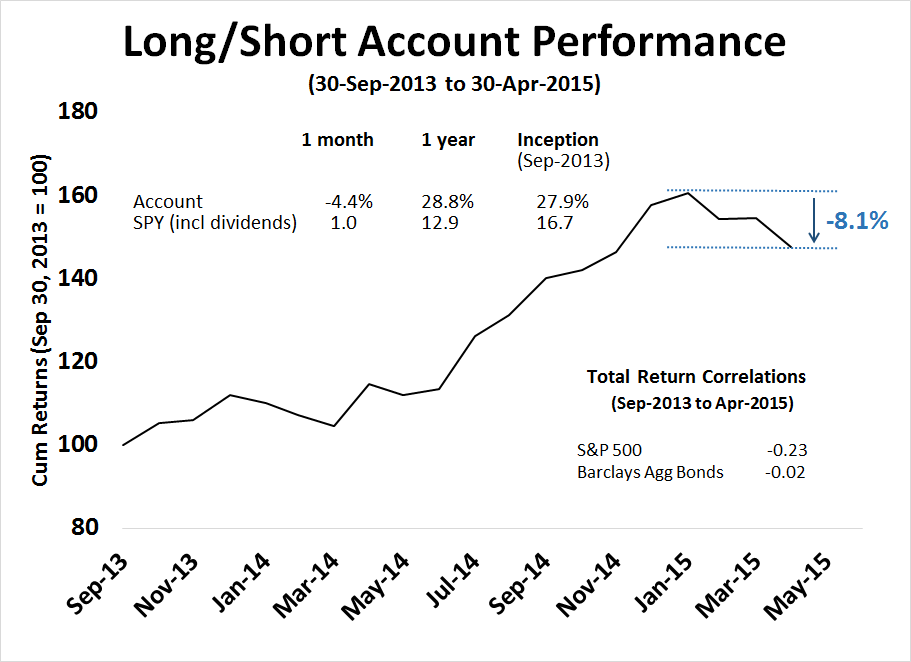
I reiterate my disclaimer that I have nothing to sell anyone right now. I am not currently in a position to manage anyone`s money based on the investment strategy that I am describing.
Trend Model description:
For readers who are unfamiliar with my Trend Model, it is a market timing, or asset allocation, model which uses trend following techniques as applied to commodity and global stock market prices to generates a composite Risk-On/Risk-Off signal (risk-on, risk-off or neutral). I have begun updating readers on the Trend Model signals on a weekly basis and via Twitter @humblestudent as new developments occur.
The chart below shows the actual (not back-tested) changes in the direction of the signal, which are indicated by the arrows, overlaid on top of a chart of the SP 500. You can think of the blue up arrows, which occurred when the trend signal changed from negative to positive, as buy signals and the red down arrows, which occurred when the trend signal changed from positive to negative, as sell signals.
Trend Model Signal History
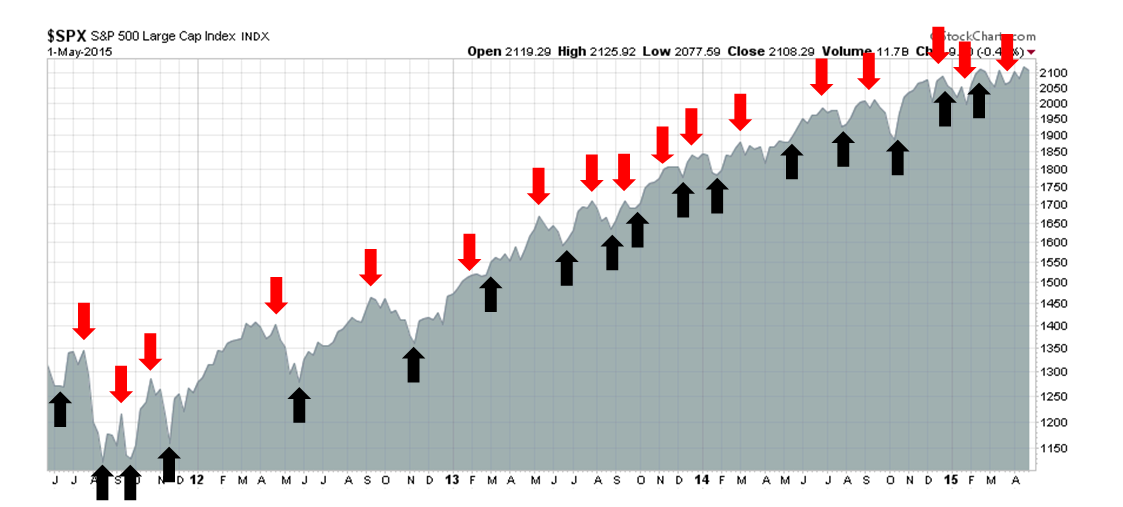
A proof of concept
While the results from the above chart representing paper trading is interesting, there is no substitute for actual performance. As a proof of concept, I started to manage a small account that traded long, inverse and leveraged ETFs on the major US market averages and, on occasion, sector and industry ETFs. Trading decisions were based on Trend Model signals combined with some short-term sentiment indicators. The inception date of the account was September 30, 2013 and the chart below represents an interim report card of that account. (For more details on how the Trend Model or how the account is managed, see my post Trend Model FAQ).
When evaluating the performance of this trading account, keep in mind that this is intended to be an absolute return vehicle. While I do show the ARCA:SPY total return, which includes re-invested dividends, for illustrative purposes, the SP 500 is not an appropriate benchmark for measuring the performance of this modeling technique.
A difficult environment
The account performance continued to be challenging this years, as it was up -4.4% in April and -6.4% YTD, though one year returns at 28.8% and returns from from inception (September 2013) of 27.9% are quite respectable.
Negative returns were affected by the difficult environment. The chart of past signals below shows that choppy markets this year have resulted in choppy whipsaw signals which detracted from returns.
Trend Model Signal History
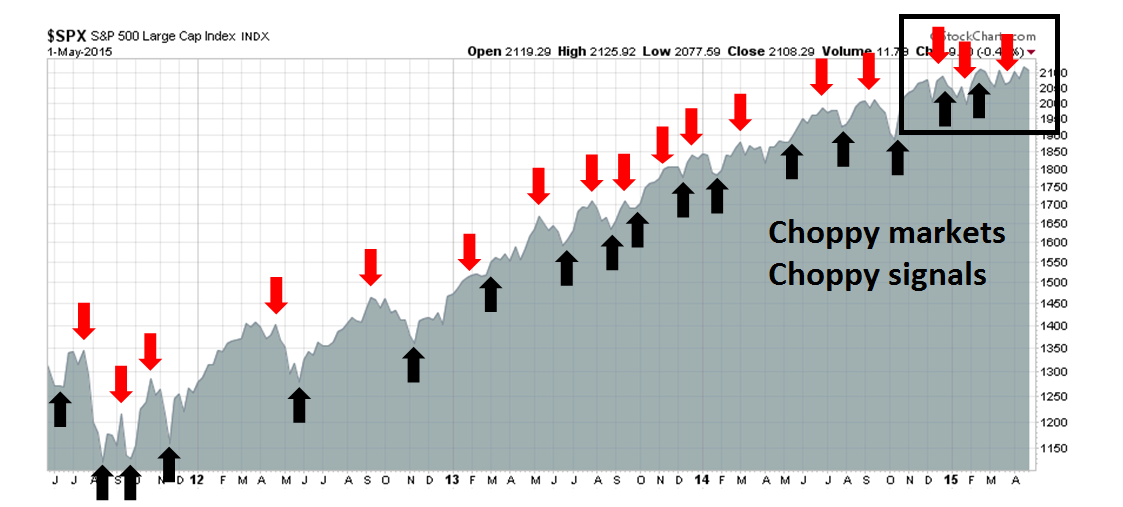
Returns were too good...
I have documented the current market environment in a past post (see How to make your first loss your best loss). Put simply, Trend Model returns have been too good. The recent history of 30-40% returns were supported by a stock market that went steadily up without a correction for several years. Now it`s payback time and a key test of how this strategy plays defense under adverse conditions.
A friendlier environment around the corner
However, I am optimistic that the pattern of short-term choppiness is about to end and the Trend Model will show more positive returns in the near future. My analysis is based on a study by James Paulsen of Wells Capital Management which showed that when a long-term stock market price trend is extended, as it is now, such conditions have led to reversals. I extended the analysis to show that the differential between the long-term (3-year) trend and short-term (6-month) trend is at levels consistent with past major inflection points like the Crash of 1929 and 1987 (bottom panel of chart). However, I would like to emphasize this analytical approach only predicts direction, not magnitude and therefore a major market crash is unlikely.
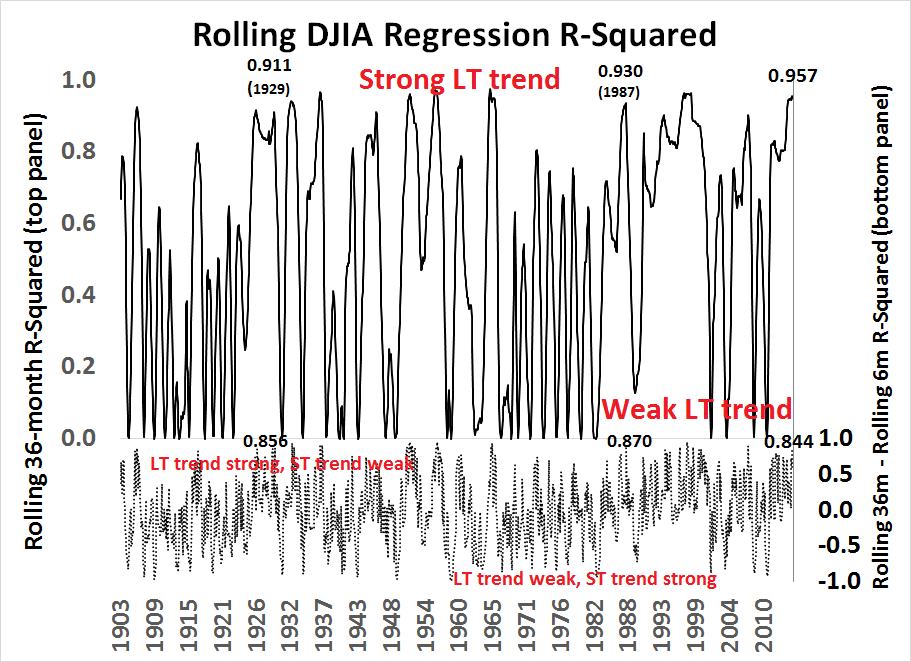
Incidentally, the short-term 6-month trend is similar to the Trend Model lookback period. Therefore its choppiness accounts for its recent disappointing strategy performance.
We can view the difference in long and short term trends from another perspective. MACD, which measures the divergence and convergence between long and short term moving averages, has deteriorated for US equities. The 20-year chart below depicts the monthly MACD readings (bottom panel) for the SPX. Note how the bars have gone negative, indicating that long and short-term trends have diverged. Such episodes have either seen the market either in bearish episodes on a coincidental basis or soon thereafter.
Negative MACD signals a bull to bear trend shift
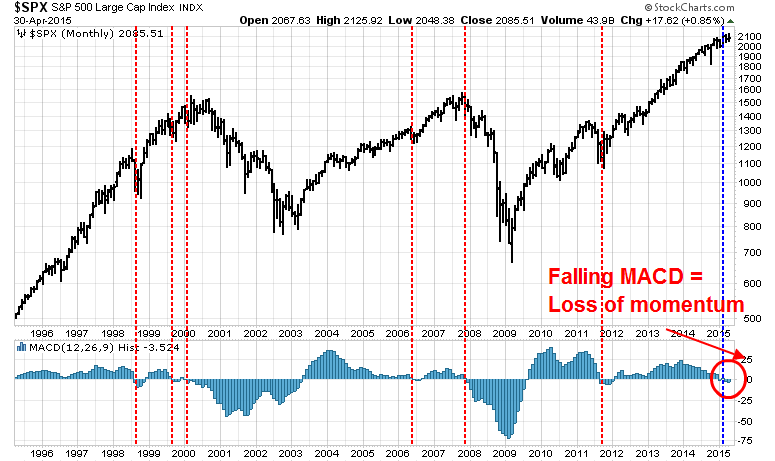
In other words, the stock market appears to be topping and therefore we are seeing flat and choppy markets, which has led to disappointing Trend Model account returns. Once the market begins to fall, the Trend Model should spot the bearish impulse and profit by shorting into the decline, which I expect to be no worse than the 10-20% corrective episodes seen in 2010 and 2011.
Strategy characteristics still promising
Despite the challenging environment and near-term returns, keep the following in mind:
- You can't expect to make 20% (my best guess long-term estimate for this strategy) without a 10-15% drawdown. So far, the drawdown has been 8.1%. Most hedge funds aim for a return to maximum-drawdown ratio of 2 to 1, but a 1.5 to 1 to 1 is a more realistic target. By comparison, the drawdown for equities was in the order of 50% and most balanced funds saw losses of about 20% during the 2008-2009 period. Using even a 1 to 1 ratio and working backwards, it would be hard to envisage a long-term return expectation of 50% for stocks and 20% for balanced funds today.
- Long term returns continue to be respectable. The one-year return was 28.8% and return from inception (September, 30, 2013) was 27.9%.
- Returns are highly diversifying compared to major asset classes. They are uncorrelated with equities (correlation of -0.23 with SPY) and bonds (-0.02 with AGG).
- Returns are consistently positive, with a 68% monthly batting average.
2015: An acid test year The market environment in 2015 has been challenging for the Trend Model trading strategy in 2015. In a year-end 2014 review, I postulated a positive year for US stock prices but with a much higher (see 2015: Bullish skies with scattered periods of volatility). Trend following models do not perform well in choppy markets. However, I believe that environment should turn more positive for this model soon as stock prices should start to trend downward soon and the strategy should profit by shorting into the downtrend.
To summarize, investment results this year have been challenging but continue to be promising for this model longer term. I am comfortable that the current hiccup in returns is a characteristic of a difficult environment for this class of model and that the environment becomes more favorable in the near future.
DISCLAIMER: Cam Hui is a portfolio manager at Qwest Investment Fund Management Ltd. ("Qwest"). This article is prepared by Mr. Hui as an outside business activity. As such, Qwest does not review or approve materials presented herein. The opinions and any recommendations expressed in this blog are those of the author and do not reflect the opinions or recommendations of Qwest.
None of the information or opinions expressed in this blog constitutes a solicitation for the purchase or sale of any security or other instrument. Nothing in this article constitutes investment advice and any recommendations that may be contained herein have not been based upon a consideration of the investment objectives, financial situation or particular needs of any specific recipient. Any purchase or sale activity in any securities or other instrument should be based upon your own analysis and conclusions. Past performance is not indicative of future results. Either Qwest or Mr. Hui may hold or control long or short positions in the securities or instruments mentioned.
